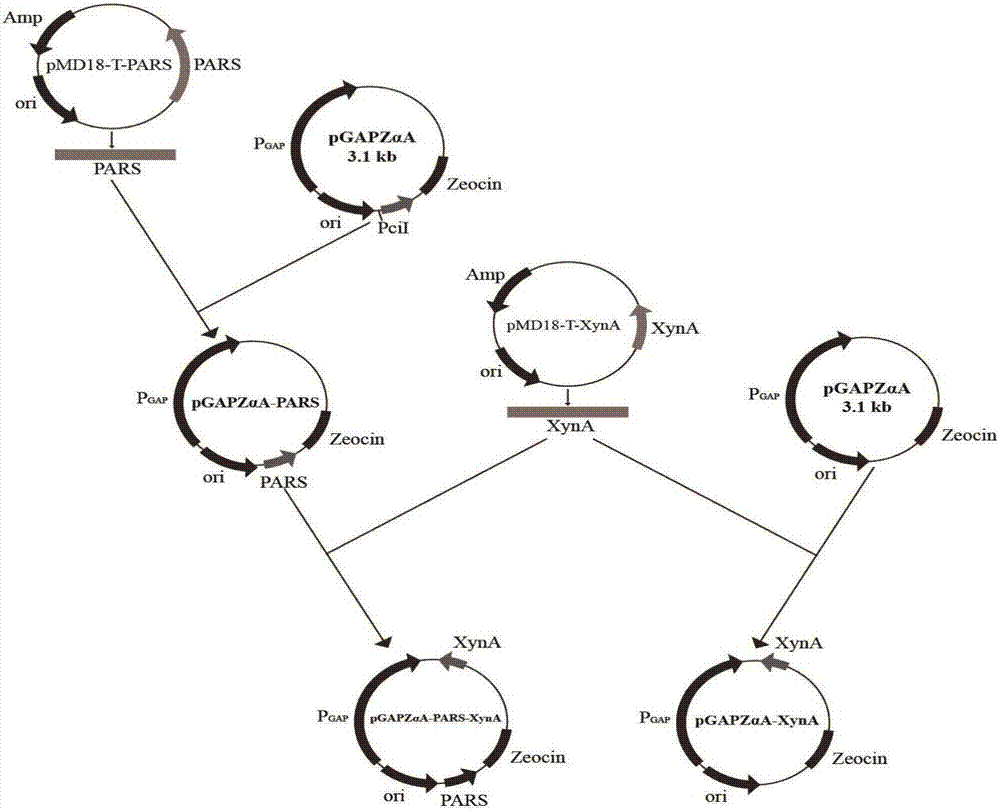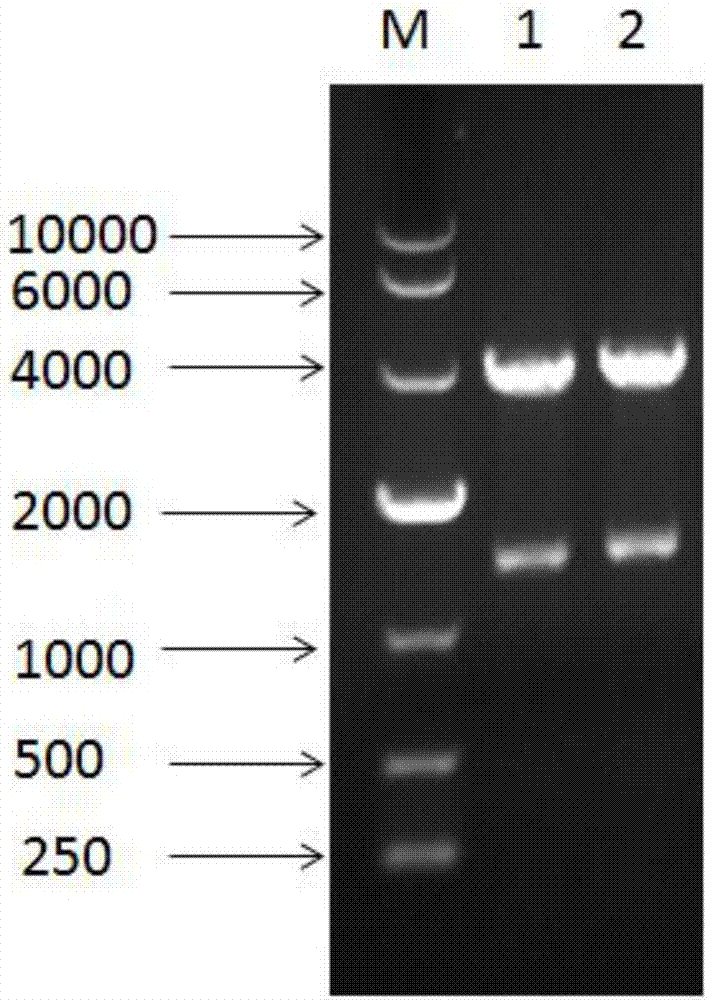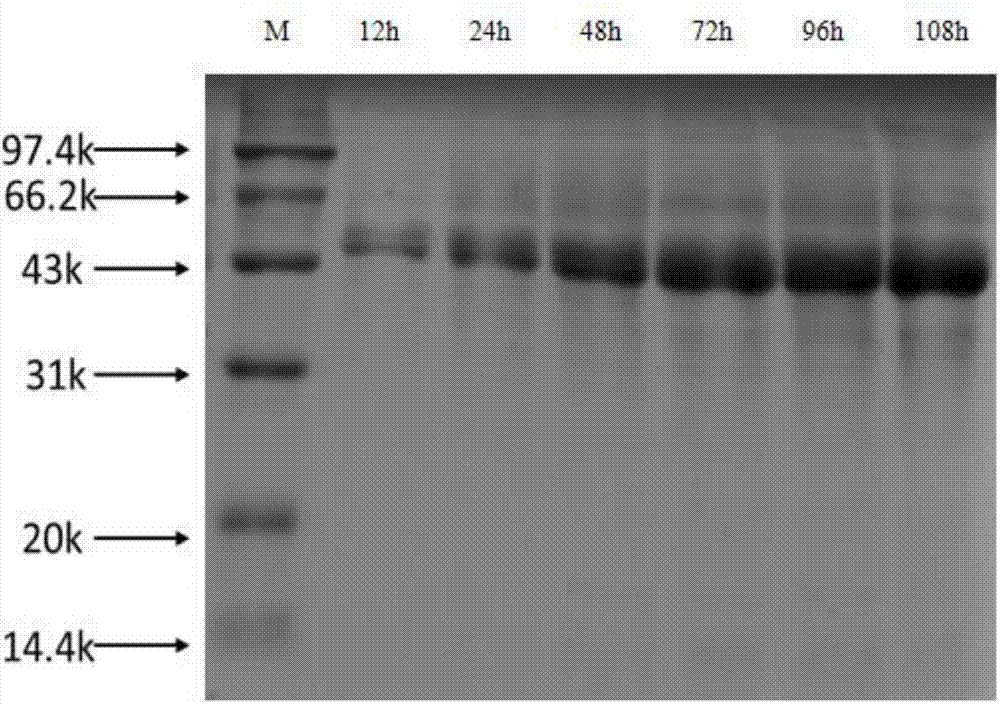Pichia yeast recombinant bacteria for expressing Streptomyces sp. FA1 (fertilization antigen 1) source xylanase
A technology of Pichia pastoris and xylanase, which is applied in the field of genetic engineering, can solve problems such as the expression of episomal expression plasmids that have not yet been seen, and achieve the ability to improve the ability to secrete and produce xylanase, with low production costs and increased specific activity Effect
- Summary
- Abstract
- Description
- Claims
- Application Information
AI Technical Summary
Problems solved by technology
Method used
Image
Examples
Embodiment 1
[0034] Example 1: Construction of expression vector pGAPZαA-PARS
[0035] The self-replicating sequence PARS whose nucleotide sequence is shown in SEQ ID NO. 2 was synthesized by the whole gene synthesis technology; the recovered PARS gene fragment was connected with the plasmid pGAPZαA by infusion enzyme, and the expression vector pGAPZαA-PARS was constructed.
Embodiment 2
[0036] Example 2: Construction of episomal pGAPZαA-PARS-XynA recombinant bacteria
[0037] Construction of recombinant plasmid pGAPZαA-PARS-XynA:
[0038] Using plasmid pMD18-T-XynA (A xylanase from Streptomyces sp.FA1: heterologousexpression, characterization, and its application in Chinese steamed bread, YangXu, Journal of Industrial Microbiology & Biotechnology, May 2016, Volume43, Issue5, pp 663-670) as a template, Design a forward primer whose sequence is shown in SEQ ID NO. 3: CCGGAATTCATGGCCGAGAACACCCTT, and a reverse primer whose sequence is shown in SEQ ID NO. 4: ATTTGCGGCCGCTCAGGTGCGGGTCCAGCGTT. The XynA fragment with Not I and EcoR I restriction sites was obtained by polymerase chain reaction.
[0039]PCR reaction system (50μL):
[0040]
[0041] PCR program: 94°C, 4min (pre-denaturation); 98°C, 10s (denaturation); 60°C, 5s (annealing); 72°C, 90s (extension); set 30 cycles; set after 72°C, 10min (insulation) The storage temperature is 4°C. The PCR product was...
Embodiment 3
[0049] Example 3: Construction of integrated pGAPZαA-XynA recombinant bacteria
[0050] Construction of recombinant plasmid pGAPZαA-XynA:
[0051] Using the plasmid pMD18-T-XynA as a template, design a forward primer with the sequence shown in SEQ ID NO.3: CCGGAATTCATGGCCGAGAACACCCTT, and a reverse primer with the sequence shown in SEQ ID NO.4: ATTTGCGGCCGCTCAGGTGCGGGTCCAGCGTT. The XynA fragment with Not I and EcoR I restriction sites was obtained by polymerase chain reaction.
[0052] PCR reaction system (50μL):
[0053]
[0054] PCR program: 94°C, 4min (pre-denaturation); 98°C, 10s (denaturation); 60°C, 5s (annealing); 72°C, 90s (extension); set 30 cycles; set after 72°C, 10min (insulation) The storage temperature is 4°C. The PCR product was gel-recovered and digested to recover the target gene, which was digested with the expression vector pGAPZαA and ligated overnight at 16°C, transformed into E.coliJM109, coated with an LB plate containing zecoin resistance, and cul...
PUM
 Login to View More
Login to View More Abstract
Description
Claims
Application Information
 Login to View More
Login to View More - R&D
- Intellectual Property
- Life Sciences
- Materials
- Tech Scout
- Unparalleled Data Quality
- Higher Quality Content
- 60% Fewer Hallucinations
Browse by: Latest US Patents, China's latest patents, Technical Efficacy Thesaurus, Application Domain, Technology Topic, Popular Technical Reports.
© 2025 PatSnap. All rights reserved.Legal|Privacy policy|Modern Slavery Act Transparency Statement|Sitemap|About US| Contact US: help@patsnap.com



